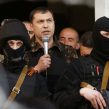
Luhansk: The Other ‘People’s Republic’ in Eastern Ukraine
Publication: Eurasia Daily Monitor Volume: 11 Issue: 151
By:

The secessionist “Luhansk People’s Republic’s” (LPR) leadership is experiencing even greater turmoil, compared with that of the adjacent “Donetsk People’s Republic” (DPR) in Ukraine’s east. On August 14 the “head (glava) of the republic,” Valery Bolotov, returned to Luhansk after a Moscow visit and announced his resignation (Itar-Tass, Rossiya 24 TV, August 14, 15). Some other leadership figures had already quit or were fleeing Luhansk. The fighting, provoked by secessionist forces, has inflicted more damage on Luhansk city than on Donetsk city.
The “LPR” has attracted far less Russian and Ukrainian media coverage and international attention, compared with the adjacent “DPR” in eastern Ukraine. The “LPR” is the smaller of the two (2.2 million versus 4.4 million population), poorer and relatively less heavily industrialized, with a less influential elite than that of Donetsk, and always in Donetsk’s shadow during the two decades of Ukraine’s independence. Since the outbreak of secession, Donetsk has been generating a large volume of daily news through multiple outlets, whereas Luhansk is meager in this regard.
During their secession bids since the spring of this year, the “DPR” became perhaps fortuitously the stage for Igor Strelkov/Girkin and Aleksandr Boroday, highly effective speakers and media manipulators, with Strelkov acquiring hero status in Russia. It is also in the “DPR” that the most intensive fighting has taken place. All this has left the “LPR” as “the other,” largely ignored secessionist territory. Luhansk, basically, became an ungoverned zone for free-wheeling secessionist armed groups and non-political, criminal gangs.
Bolotov, an ethnic Russian born in Russia and raised in Luhansk province, was a sergeant in the Soviet armed forces (paratroops, then artillery) and head of the local chapter of Afghanistan war veterans. In Luhansk’s “Russian Spring,” Bolotov led the armed seizure of the gubernatorial, police and state security buildings, and was acclaimed as “people’s governor” in early April. He formed a paramilitary unit, dubbed “The People’s Army of the South-East,” with Moscow’s support, and received cheerleading coverage on Russia’s state television channels. Elected “head of the republic” by its “parliament” in May, Bolotov turned out to be a reclusive figure, widely believed to be an alcoholic. His condition deteriorated after a never-explained attempt on his life. Bolotov invoked that incident to justify his resignation on August 14 (see above).
The new “head of the republic” is Igor Plotnitsky, hitherto “LPR defense minister,” and earlier a minor businessman. The “LPR prime minister,” Marat Bashirov, is a consultant from Moscow, delegated from there to Luhansk in July as a crisis manager. Several members of the “LPR parliament,” including its chairman, Aleksei Karyakin, have defected recently. Of Luhansk city’s pre-conflict population of 450,000, less than one half remain in the city at present (Gazeta.ru, July 20, 23, August 4).
The main secessionist armed groups in the “LPR” lack a unified command and are known to coordinate poorly with each other. They include:
- “Zarya” (“Dawn”) artillery brigade, nominally loyal to Bolotov, its manpower estimated at 1,000, well equipped from Russia, and considered to be “LPR’s” most effective force;
- Paramilitary units loyal their respective chieftains. These are known by their war nicknames: “Motorola,” “Lesh,” “Sergei Yugoslav” and “Pervyi” (“First”), the latter’s unit reputedly comprised of devout Orthodox. A unit of Don Cossacks also operates in the “LPR” (Mission of Ukraine to NATO, August 11, unclassified).
- “Prizrak” (“Ghost”) battalion, commanded by Aleksey Mozgovoy, rival to Bolotov, cooperating instead with Igor Strelkov/Girkin in neighboring Donetsk province (see EDM, August 13). In late July–early August, Ukrainian forces ousted Mozgovoy’s battalion from Lysychansk and Sieverodonetsk to Alchevsk.
The “LPR” and “DPR” have joined together in a “Union of the Peoples’ Republics of Novorossiya,” conceived by the Kremlin as the nucleus of a far wider “Novorossiya” in Ukraine’s east and south. This project is a failure until now in six out of the eight Ukrainian provinces targeted. “DPR”-“LPR” joint initiatives are few and far between. When they do occur, the are announced by Donetsk and received passively by Luhansk
The “DPR”-“LPR” union, formed in May of this year, has a purely symbolic “parliament” of 60 members (30 from either “republic”), chaired by Oleg Tsaryov, a Russian nationalist politician from Ukraine. He and other members of this body act mainly as distribution channels for Russian humanitarian assistance to the “DPR” and “LPR.”
At this juncture, Donetsk city and Luhansk city are, each, almost encircled and almost cut off from each other by Ukrainian forces. The border with Russia, however, remains open, resulting in high casualties for the Ukrainian forces.




